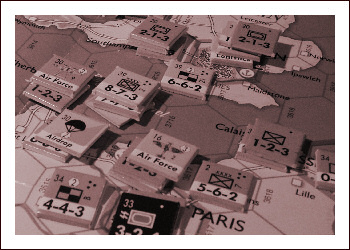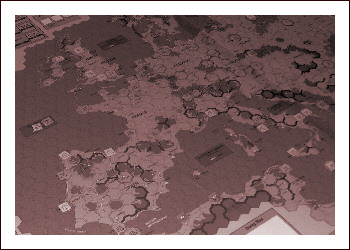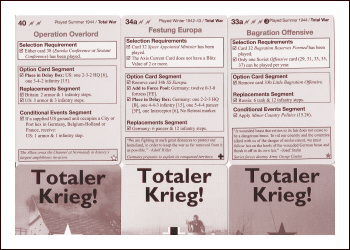|
|
|
|
Introduction Totaler Krieg! is a 2-3 (or 4) player WWII grand tactical board game, covering the entire war in Europe, starting as early as 1937 with the newest version – there is also a sister game, which will include the Pacific Theater. There should be no doubt that Totaler Krieg! is a land warfare game, everything else has been neatly abstracted, which cuts down on tedious book-keeping and complexity of the rules.
But more than that – Totaler Krieg! (or at that time just Krieg!) is the game that got me into WWII.
I have been interested in history for as long as I remember, at least from the time when I got my first computer and started playing Civilization – but that is quite another story. It was not WWII, however, that got most of my attention, it was the great wooden ships and bright uniforms of the age of exploration – and that did get me fascinated with the history of the United Kingdoms.
Then, while in high school, a somewhat older friend introduced me to Krieg!. Although I was not completely ignorant of WWII, I only knew little more than I had been taught in school – which went a little like this: Germany conquered most of Europe with little effort, then the British and Americans landed in Normandy and won the war. It was during the cold war, and the Soviet Union was our enemies, so no one really cared much about what had happened in that part of the world.
|
|
 D-Day in Axis Empires: Totaler Krieg! D-Day in Axis Empires: Totaler Krieg!
As you might expect, my first game was a resounding defeat. As you might have guessed, I played the Western Allies, and I was quite surprised that I had to fight in the North African Desert. Then I started studying WWII! And it has fascinated me deeply ever since.
The game itself has captivated me as well, it is a game fairly easy to learn, yet complex and difficult to master. The rules have evolved quite a bit since I played Krieg, two new versions (Totaler Krieg! and Axis Empires: Totaler Krieg!) have been published since, and between those, a number of play test versions that were freely available through the official homepage – a few of which I have played as well. And although the rules have been expanded and have become increasingly more complex, the rules are still perfect in almost any aspect – at least from my point of view – let me elaborate that further.
|
|
The Rules Themselves The rules are very well written – what I mean by that, is that language is consistent throughout the rules, key terms are well defined and there are good examples throughout the book. The rules are ordered very well and in line with the sequence of play, and rules that you come across so rarely that you have to look them up, are in their own section of look-up rules. This not only makes them easy to find when needed, it also ensures that they do not muddy the core rules unnecessarily – and everything is thoroughly referenced by an easy to grasp numerical system.
 Complete game, crafted from an early play test kit Complete game, crafted from an early play test kit
|
|
I probably did not give much thought to this when I started to play Krieg!, but every game that I have met since, leaves me longing for this structure.
The rules are also readily available where needed, either printed in short form or reference on the map, back of counter, force pool display or player’s aid available to each faction. This means, that after a game or two, you’ll only need to grab the rules whenever one of those “look-up” situations occur – or if you want to psyche your opponent – more on that later.
Finally, the rules are not easily broken – honestly, eventually the collective memory of the players are going to remember the rules wrong – when that happen, some games can be broken quite easily, but Krieg! will probably survive as long as that misremembered rule is applied consistently to all players.
I think every game I have yet played from start to finish, ended with browsing through the rules and go: ”Hey, we have to remember this next game.”
But I don't remember a game where that had actually changed the outcome significantly.
|
|
The Strategic Level Everything regarding production, research, strategic warfare, operational focus and politics is abstracted in Totaler Krieg! Most of it is covered by the option cards, of which you select one in secrecy every season. In secrecy, because the card you just selected will not be revealed for another season, and this season the previous selected option card will be revealed and come into effect. So, you will have to plan one season ahead, at the strategic level.
Other aspects of the strategic level is handled by political posture, war states, victory points and US commitment level, most of which is influenced by option cards or the accomplishments on the map. These have various effects upon the strategic level, for instance, a high Axis victory point level will grant the Axis production benefits, whereas a high US commitment level will do the opposite.
|
|
A few aspects of the strategic level have been put into support units (air forces and navies) in the later versions
 Examples of option cards Examples of option cards
The end result of all this, is a strategic level that does not take much time away from the tactical warfare, and require no elaborate book-keeping, which I regard as one of the main strengths of Totaler Krieg! over its competitors.
|
|
The Tactical Game The rules are very well written – what I mean by that, is that language is consistent throughout the rules, key terms are well defined and there are good examples throughout the book. The rules are ordered very well and in line with the sequence of play, and rules that you come across so rarely that you have to look them up, are in their own section of look-up rules. This not only makes them easy to find when needed, it also ensures that they do not muddy the core rules unnecessarily – and everything is thoroughly referenced by an easy to grasp numerical system.
 Complete game, crafted from an early play test kit Complete game, crafted from an early play test kit
|
|
I probably did not give much thought to this when I started to play Krieg!, but every game that I have met since, leaves me longing for this structure.
The rules are also readily available where needed, either printed in short form or reference on the map, back of counter, force pool display or player’s aid available to each faction. This means, that after a game or two, you’ll only need to grab the rules whenever one of those “look-up” situations occur – or if you want to psyche your opponent – more on that later.
Finally, the rules are not easily broken – honestly, eventually the collective memory of the players are going to remember the rules wrong – when that happen, some games can be broken quite easily, but Krieg! will probably survive as long as that misremembered rule is applied consistently to all players.
I think every game I have yet played from start to finish, ended with browsing through the rules and go: ”Hey, we have to remember this next game.”
But I don't remember a game where that had actually changed the outcome significantly.
|
|